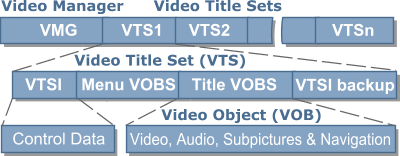DVD-Video discs are structured to contain video, audio and subpicture streams
DVD-Video discs contain video, audio and other data using a specific disc structure and directory and file structure. Within files the data are organized as data streams.
![]() DVD-Video Disc Structure
DVD-Video Disc Structure
DVD-Video titles consist of a hierarchical structure as illustrated below. A DVD-Video disc is divided into Video Title Sets (or titles). As a minimum there will be one Video Manager (VMG) and one VTS. A
disc containing a movie plus documentary about the making of the movie is likely to be divided into two titles. A disc containing six episodes of a TV program would be divided into six titles. However in
both cases it is possible to have only one title per disc.

Each Video Title Set Information (VTSI) comprises control data and Video Objects (VOBs) for both menus (if present) and titles (stills and video). Each VOB (the fundamental file element of the disc) comprises video, audio, subpictures and navigation data. When a VOB is played the player not only plays the video sequentially but obeys the navigation instructions for displaying menus, getting user selections, etc.
Each VOB comprises individual cells linked together by Program Chains (PGCs), which provide the necessary interactivity using a simple programming language developed for DVD-Video. PGCs are used to control the playing of video, audio and subtitles in VOBs, to display menus and input and obey user commands. There are three types of PGC: sequential play, random play and shuffle play. Individual cells may be used by more than one PGC, which can define different sequences through the video content, for example to implement seamless branching. PGCs allow a command set for simple programming including mathematical and logical operators, conditional branching, countdown timer etc. There are 16 general registers for more complex programming and 24 system registers.
![]() Files and directories
Files and directories
The VOBs and other data are contained in files in the VIDEO_TS directory. The table below gives an example of these files for a single title set disc. The audio, video and subpictures for the movie are
contained in up to 9 Title VOB files, where each file is not more than 1GB in size. For a DVD-5 there will be no more than 5 Title VOB files, for a DVD-9 a full 9 will be required if the disc is full.
| Filename | Description |
| VIDEO_TS.IFO VIDEO_TS.VOB VIDEO_TS.BUP |
VMGI file (Video Manager Information) VOB file for VMG Menu VMGI backup file |
| VTS_01_0.IFO VTS_01_0.VOB VTS_01_0.BUP |
VTSI file (VTS Manager Information) Video Object Set for VTS Menu VTSI backup file |
| VTS_01_1.VOB VTS_01_2.VOB . . . . . . VTS_01_n.VOB |
First Title Video Object Set file Second Title Video Object Set file . . . . . . Last Title Video Object Set file (n not more than 9) |
The VTS*.* files can be repeated for each VTS and will be named VTS_02*.*, VTS_03*.* etc. Each VTS will have one each of the .IFO and .BUP files plus one or more .VOB files.
![]() DVD-Video Data Streams
DVD-Video Data Streams
To meet the Hollywood requirements, DVD-Video discs are designed to store audio visual sequences each comprising data streams of four types of data:
| Data type | Streams | Max data rate | Coding |
| Video | 1 | 9.08 Mb/s | MPEG-1 or MPEG-2 video and video stills |
| Audio | up to 8 | 6.144 Mb/s | Several audio formats available for both stereo & surround sound |
| Subpictures | up to 32 | 3.36 Mb/s | 2 bits/pixel run length encoded subpictures |
| Navigation | 1 | - | Program Chains to provide interactivity |
The maximum bit rate is 9.8 Mb/s for video, audio and subpictures (the overall maximum, including control information, being 10.08 Mb/s). For a playing time of 133 minutes, the average bit rate is 4.7 Mb/s. The average video bit rate available depends on the number of audio streams and the encoding used, but should be close to 4 Mb/s for high quality results. Higher bit rates are often used to give even higher video quality.
